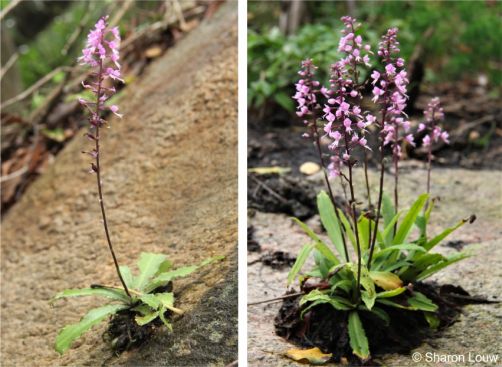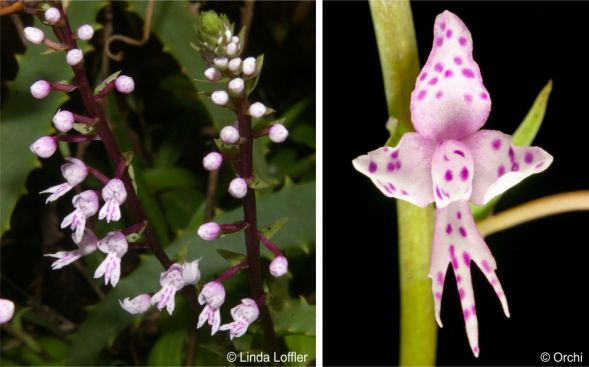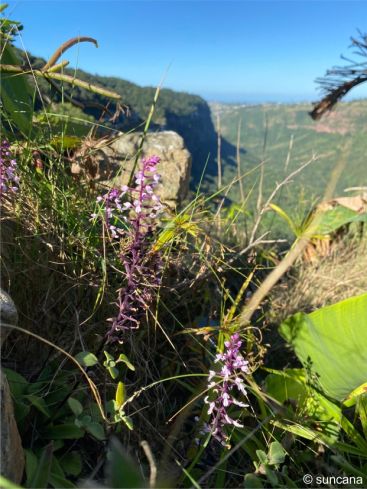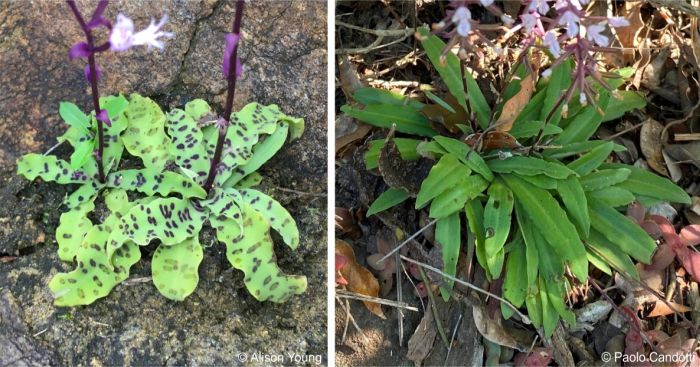Stenoglottis longifolia
Stenoglottis longifolia Hook.f.
Family: Orchidaceae
Common names: long-leaved stenoglottis
Introduction
The long-leaved stenoglottis is an attractive, relatively easy-to-grow orchid that charms with its graceful spikes of lilac to mauve flowers. It naturally thrives on rocks or in shallow soil and is an excellent choice for sheltered outdoor spaces in frost-free areas or as a pot plant.

Fig. 1. Stenoglottis longifolia growing on its preferred rocky substrate.
Description
Description
Stenoglottis longifolia is a deciduous orchid that grows on rocks or more rarely in soil. It is an herbaceous perennial with tuberous roots that grows 300–800 mm tall. Plants have 7–15 leaves arranged in a basal rosette. The leaves are lanceolate to linear, up to 210 mm long and 30 mm wide, usually plain green but sometimes sparsely or heavily spotted with brown or maroon. Leaf margins are flat to weakly undulate. The inflorescence is a slender, erect, lax raceme up to 800 mm long, bearing 20–120 flowers. Floral bracts are lanceolate to heart-shaped, 7–17 mm long and 2.5–4.5 mm wide, spotted or unspotted, and distinctly recurved. The flowers are white, pink or lilac to mauve, often spotted with a darker shade of pink or purple on all parts. The sepals are ovate with the dorsal sepal being concave and the lateral sepals oblique, while the petals are ovate and oblique. The lip is unspurred and 7.9–15.0 mm long and 3.5–8.6 mm wide. Side lobes usually have 2–5 fimbriae of variable lengths, sometimes ligulate and entire or shallowly incised. The midlobe is acute to attenuate, longer than or subequal to the side lobes. The column is up to 2 mm long with suberect or parallel stigmatic arms in mature flowers, curving outward. Auricles are large and club-shaped, up to 0.8 x 0.6 mm at the apex, projecting beyond the anther between the pollinia and stigmas. The fruit are dry, elongated capsules, 8–22 mm long, that split open to release numerous minute, dust-like seeds.
Stenoglottis longifolia can be distinguished from the considerably similar S. fimbriata by its recurved floral bracts and club-shaped auricles that project beyond the anther (compared to sheathing floral bracts and linear auricles adnate to the sides of the anther in S. fimbriata). Unlike S. inandensis, S. woodii and S. macloughlinii, S. longifolia lacks a spur on the lip.

Fig. 2. The beautiful flowers of Stenoglottis longifolia.
Conservation Status
Status
Stenoglottis longifolia is currently assessed as Least Concern (LC) by the Red List of South African Plants and is therefore not threatened. This status has remained unchanged over multiple assessments since 1996 and the population trend is considered stable.
Like all orchid species, S. longifolia is protected under the Convention on International Trade in Endangered Species of Wild Fauna and Flora (CITES). This international agreement aims to ensure that international trade in wild plants and animals does not threaten their survival. As a member of the Orchidaceae family, S. longifolia is included in CITES Appendix II. This means that while international trade is allowed, it is regulated to prevent over-exploitation.
Distribution and habitat
Distribution description
Stenoglottis longifolia is a summer-rainfall plant that occurs naturally in KwaZulu-Natal, South Africa, extending into the Lebombo Mountains of Eswatini and southern Mozambique. It is usually found at elevations between 230 and 1 200 m. Although previously reported from the Eastern Cape, recent taxonomic revisions refuted its presence in this province. Its natural range is characterised by annual rainfall of between 1 000 and 1 500 mm. Winter temperatures can approach freezing, but prolonged frost is rare.
Stenoglottis longifolia plants usually grow in forests or along forest margins in areas with deep or partial shade. They grow as lithophytes (plants that grow on rocks) on boulders, frequently along streams or on south-facing cliff faces, or more rarely in streambanks and the forest floor. S. longifolia prefers moist, humus-rich conditions, often establishing itself in rocky crevices or on moss-covered rocks in leaf litter and other organic matter.

Fig. 3. Stenoglottis longifolia in its natural habitat, eThekwini, KwaZulu-Natal.
Derivation of name and historical aspects
History
The genus Stenoglottis is a small genus of five species endemic to sub-Saharan Africa. Its centre of diversity is in the summer-rainfall regions of eastern South Africa and its range extends northwards to the southern highlands of Tanzania. Stenoglottis forms part of the orchid family, Orchidaceae, which is one of the largest families of flowering plants. Orchidaceae is considered to be one of the most important plant families both ecologically and horticulturally. Orchids are known for their highly specialised flowers, which have evolved intricate mechanisms for pollination, often forming exclusive relationships with specific insect pollinators. This family is also of great economic importance, being one of the most widely cultivated plant groups globally. Orchids are prized for their exotic and often long-lasting flowers, making them popular in the horticultural trade as ornamental plants and cut flowers. Stenoglottis is placed in the subfamily Orchidoideae and the tribe Orchideae. Recent molecular studies suggest it belongs to the subtribe Orchidinae.
Stenoglottis longifolia was first described by Joseph Dalton Hooker in 1891, making it the second species to be described in the genus after S. fimbriata, which was described by John Lindley in 1837. The genus remained poorly understood for many years and has been the subject of several taxonomic studies due to the substantial morphological variation within and between species, making species boundaries difficult to define. The most recent comprehensive study by Phillips and Bytebier in 2020, used a combination of molecular and morphological data to revise the taxonomy of the genus. S. longifolia itself has been involved in some taxonomic confusion. A taxon previously described as S. molweniensis is now considered synonymous with S. longifolia, as no consistent morphological or genetic differences were found to separate them.
The name Stenoglottis is derived from the Greek words stenos, meaning ‘narrow’, and glotta, meaning ‘tongue’, which refers to the narrow and lacerate lip of the type species, S. fimbriata. The specific epithet longifolia comes from the Latin words longus meaning ‘long’ and folium meaning ‘leaf’, referring to the relatively long leaves of this species compared to others in the genus.

Fig. 4. Examples of the leaf variation found in Stenoglottis longifolia plants.
Ecology
Ecology
Unlike some closely related species, S. longifolia does not exhibit spontaneous self-pollination, indicating a reliance on insect pollinators for reproduction.
Uses
Use
Stenoglottis species are valued as ornamental shade-house plants due to their numerous and attractive flowers, as well as their relative ease of cultivation. This makes them popular choices for orchid enthusiasts and home gardeners alike. Lithophytic orchids in general are prized in horticulture for their unique growth habits and attractive flowers. Genera such as Dendrobium, Cattleya and Phalaenopsis are particularly valued for their showy blooms and have been extensively hybridised to produce a wide array of colours and forms. Some lithophytic orchids, like certain Bulbophyllum species, are sought after by enthusiasts for their unusual flower structures and intriguing fragrances.

Fig. 5. The impressive display of Stenoglottis longifolia in cultivation at the Botanic Garden Berlin.
Growing Stenoglottis longifolia
Grow
Stenoglottis longifolia is one of the more easily grown species of terrestrial orchids. They can be grown as pot plants or in gardens in areas with cool Mediterranean or warm temperate climates. These plants grow in spring and summer (October to February), flower in autumn and winter (February to July) and are dormant during the winter. The lilac flowers open sequentially from the bottom of the spike upwards, providing several weeks of blooms. With proper care, plants may multiply to form large clumps over time. While not as showy as some epiphytic orchids, its ease of care and beautiful autumn flowers make it a rewarding plant to grow.
Propagate S. longifolia plants using tubers. Propagation using seeds is not recommended, due to the challenge of artificially pollinating the small flowers and collecting and planting the microscopic seeds. Plant tubers in spring or early summer in a light, well-aerated growing medium with very good drainage. There are several suitable options for potting mix. A regular potting mix loosened with sand and small pieces of pumice works well, mimicking the plant’s natural lithophytic (growing on rock) habitat. Alternatively, use six parts medium river sand, two parts compost and one part peat moss, or a mixture of nine parts shredded bark and one part medium river sand. Plant tubers about 2 cm deep, ensuring the growing point is just below the soil surface.
Grow S. longifolia plants in areas with dappled sunlight or bright, indirect light. Avoid full sun exposure, which can damage the plants. In colder climates, plant in sheltered areas or grow in a pot that can be moved to protected spots during freezing weather. Stenoglottis longifolia grows optimally at temperatures between 20 and 35°C in summer and 6 to 22°C in winter.
Water plants regularly during the growing season (spring and summer) by thoroughly drenching the soil. Adjust watering according to local conditions. Once the leaves start to turn yellow, stop watering and feeding as the plant enters dormancy. During the dormant period, moisten the soil every two to three weeks to prevent the tuber from dehydrating. Store potted tubers in a cool, dry place with temperatures between 10 and 15°C. They can be left in the ground in suitable conditions but if grown in the ground in areas with wet winters, consider lifting the tubers and storing them in slightly damp peat moss or vermiculite to prevent rotting. Check occasionally for signs of fungal growth or rot, removing any affected tubers promptly. Gradually increase watering as spring approaches and move plants to a brighter location to encourage new growth.
Feed plants with a slow-release fertilizer when potting and again every spring. Additionally, during the growing season, fertilize every two to three weeks with half-strength organic fertilizer such as Nitrosol or Seagro. Alternate these with a 3:2:1 fertilizer at a strength of one teaspoon to 5 litres of water. Stenoglottis longifolia is not particularly demanding in terms of nutrients.
While S. longifolia is generally resilient to pests when grown in the correct conditions, it can be susceptible to several pests and diseases common to terrestrial orchids. Aphids may infest young growth and flower spikes, particularly in spring and autumn. Control these by washing them off with a strong jet of water or, in severe cases, using an appropriate insecticidal soap. Snails and slugs can damage new growth and flowers, especially in damp conditions. Regularly inspect plants and manually remove them or use organic pellets or copper tape around pots to provide protection. Fungal diseases such as root rot can occur if the growing medium is kept too wet, particularly during the dormant period. Ensure good drainage and avoid overwatering to prevent this issue. If rot is suspected, carefully remove the plant from its pot, trim away any affected parts with sterilised tools, and repot in fresh, well-draining medium. Mealybugs might occasionally appear, hiding in leaf axils or under old leaf sheaths. Remove these with a cotton swab dipped in rubbing alcohol. Spider mites can be a problem, especially if the plants are kept in overly dry conditions. Increase humidity and use insecticidal soap if an infestation occurs. As with most orchids, virus infections can occur, often manifesting as streaked or mottled leaves. There is no cure for viral infections. Isolate or discard affected plants to prevent spread. Regular inspection of plants, good hygiene practices and maintaining optimal growing conditions are key to preventing and managing these potential issues.
References
- BotBln. 2006. Image of Stenoglottis longifolia, Botanic Garden Berlin Orchid Exhibition. Wikipedia. Online. https://af.wikipedia.org/wiki/Stenoglottis_longifolia#/media/L%C3%AAer:Stenoglottis_longifolia_OrchidsBln0906a.JPG.
- Candotti, P. 2021. Observation of Stenoglottis longifolia, Molweni Trail, Kloof, KwaZulu-Natal. iNaturalist. Online. https://www.inaturalist.org/observations/74365030.
- Kurzweil, H., Scott-Shaw, C.R. & Victor, J.E. 2022. Stenoglottis longifolia Hook.f. National Assessment: Red List of South African Plants. Accessed on 2024/10/15.
- Loffler, L. 2005. Observation of Stenoglottis longifolia, Lubombo Region, Eswatini. iNaturalist. Online. https://www.inaturalist.org/observations/102653686.
- Louw, S. 2021. Observation of Stenoglottis longifolia, Ohaheni, KwaZulu-Natal. iNaturalist. Online. https://www.inaturalist.org/observations/80067748.
- Orchi. 2019. Image of Stenoglottis longifolia, unknown locality. Wikimedia Commons. Online. https://commons.wikimedia.org/wiki/Stenoglottis_longifolia#/media/File:Stenoglottis_longifolia_Orchi_024.jpg.
- Phillips, D.P. & Bytebier, B. 2020. A morphometric and molecular phylogenetic analysis of the African orchid genus Stenoglottis (Orchidaceae: Orchidoideae). Botanical Journal of the Linnean Society 193:340–362.
- Phillips, D.P. & Bytebier, B. 2020. A taxonomic revision of Stenoglottis (Orchideae, Orchidoideae, Orchidaceae). Phytotaxa 456:219–243.
- Suncana 2024. Observation of Stenoglottis longifolia, eThekwini, KwaZulu-Natal. iNaturalist. Online. https://www.inaturalist.org/observations/210971259.
- Truter, J.T. 1994. Mainly South African (the cultivation of the genus Stenoglottis). South African Orchid Journal 25:142–144.
- Wodrich, K. 1997. Growing South African indigenous orchids. CRC Press.
- Wodrich, K. 2018. Propagation of indigenous orchids in, Hankey A. (Ed.) Wild Orchids Southern Africa 3rd National Conference 2018 – Proceedings. Wild Orchids Southern Africa, Johannesburg.
- Young, A. 2019. Observation of Stenoglottis longifolia, Ntunjambili, KwaZulu-Natal. iNaturalist. Online. https://www.inaturalist.org/observations/198641424.
Credits
Natasha Lombard
Pretoria National Herbarium
November 2024
Acknowledgements: Images by suncana, Sharon Louw, Alison Young, Paolo Candotti, BotBln, Orchi and Linda Loffler.
Plant Attributes:
Plant Type: Orchid
SA Distribution: KwaZulu-Natal
Soil type: Sandy
Flowering season: Autumn, Winter
PH:
Flower colour: Purple, White, Mauve/Lilac
Aspect: Shade, Morning Sun (Semi Shade), Afternoon Sun (Semi Shade)
Gardening skill: Average
Special Features:
Horticultural zones







Rate this article
Article well written and informative
Rate this plant
Is this an interesting plant?
Login to add your Comment
Back to topNot registered yet? Click here to register.